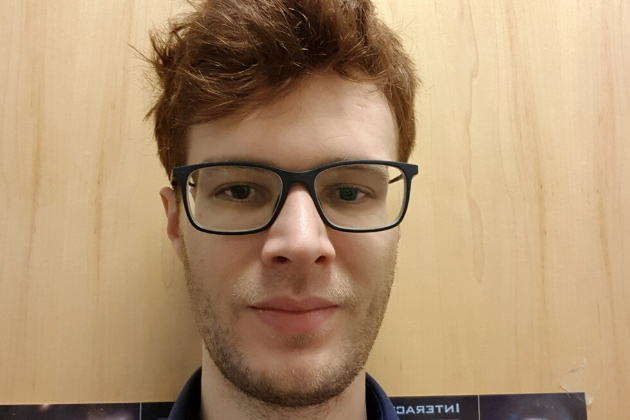Using coding to help advance healthcare
27 February 2020

Marcus Tyyger, Radiotherapy Research Physicist, explains how his interest in computing has led him into a healthcare role with a real impact on cancer patients.
I started out studying an integrated Masters in Physics (MPhys) at the University of Kent. Whilst there I studied a module in medical physics, and subsequently focused my dissertation on a novel computational method of using nuclear medicine information for dementia diagnosis.
Following my MPhys, I started the Scientist Training Programme at Leeds Teaching Hospitals Trust. This took three years, and was split between a wide range of clinical experience and achieving a Masters in Medical Physics. I opted for specialising in Radiotherapy Physics, which focuses on care and treatment of cancer.
My role as a clinical scientist requires registration with the Health and Care Professions Council. This can be achieved by either the Scientist Training Programme or by production of a relevant portfolio whilst working in a hospital. For me, the dedicated training programme suited me more and I chose to work in a large NHS trust.
Within radiotherapy physics specifically there is a large range of potential expertise. Fortunately, I found a role at Leeds with a 50-50 split between research and clinical work, which was an ideal position for me as my interest is in image processing and computational methods.
Incredibly rewarding
My role in the clinic is part of the ‘imaging team’, which unsurprisingly focuses on our use of imaging for treatments. My day can be filled with assessing radiotherapy treatment plans, performing quality assurance on linear accelerators, optimising imaging methods, attending MRI-scans, and finding ways to improve our treatment techniques locally.
The variation in work allows me to get hands-on with our treatment machines, or to spend time writing code to support our treatment delivery. As this work focuses on direct patient care, it is an incredibly rewarding part of my overall role.
My role changes significantly on research days. Instead of direct patient care, I am attempting to develop novel ideas that potentially benefit patients within five years.
This typically includes writing code to perform image-processing tasks, or trying to develop new treatment methods. An example of this is my recent focus on simulating the growth of aggressive brain tumours. In this, we have spent hours determining a method to predict tumour growth patterns, and even more time writing the code itself.
Computer scientists are invaluable
Scientific careers are increasingly reliant on computing technology, and working groups are ever expanding to become more multi-disciplinary. Computer scientists are invaluable in my field, but there are currently very few scattered around the country. We are all looking to support the development of new generations of computer scientists, or scientists with interests in computing. All we need now is more people!
Medical physics can be difficult to gain experience in prior to degree level, but asking to visit departments and learn more about the area is incredibly useful. For me, this was invaluable when applying for the Scientist Training Programme. It was important that I had actively attempted to learn more about a career in medical physics, and that it was a career aspiration.
Given the nature of the work there are understandably some emotionally difficult days. However, as with any healthcare role the support of others gets you through it.
One part I was not expecting to find as difficult was the pragmatism necessary in my role. As a scientist, I always want to know as much information as possible before deciding the answer to a question. However, in some clinical scenarios you do not have all the information you would like and all you can do is decide the most appropriate option. This can be a challenge, but it is very rewarding when you can apply your knowledge and experience in these contexts.
Given my interest in coding, my role has adapted to enable more of my work to be focused on computational methods. This has meant everything from supporting image processing analysis of others, to developing in-house code for both research and clinical tasks.
Career ambitions
My career ambitions are all focused on my research, working collaboratively with other departments around the world, and attempting to determine better treatment options for our patients.
I love my role because of its direct impact on patient care and outcomes. This never fails to be the priority of our work, and my department is incredibly focused on our patients.
For me personally, I feel incredibly fortunate to be in a role that allows my interests as a scientist to be used to support the care of cancer patients. Knowing my research has the potential to further improve the outcomes of patients is such a strong driving force. Less than 10 years ago, I did not know what a Clinical Scientist was, and now I can't picture myself ever working in a different environment.
Marcus’s career advice
Becoming a clinical scientist can be challenging, but initially all it requires is determining if the roles are potentially interesting to you. For me, this included a module at university. However, outside of a degree the two most accessible methods are arranging to visit a relevant department in a local hospital, or reading material from relevant industry bodies.
We need more clinical scientists, meaning departments happily facilitate visits to show you what our roles are like and industry bodies publish lots of material for those interested in our field. For example, the Institute of Physics and Engineering in Medicine (IPEM) has whole sections dedicated to why medical physics is amazing and potential pathways to it as a career.